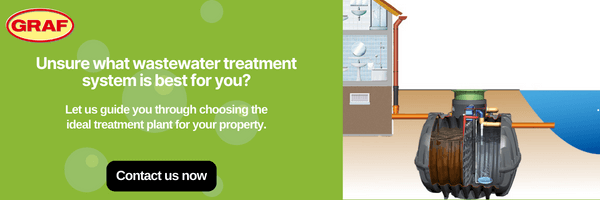If you are looking to build a property that cannot be connected to the main sewer network, then you will need to install some form of sewage treatment system to process the wastewater so that it can be safely discharged into your local water course or into a soakaway. The most common approach to this is to install a sewage treatment plant.
A sewage treatment plant is an off-mains drainage system that treats waste coming from a property, to a point where it can safely re-enter the water cycle or groundwater reserves without causing damage to the local environment or eco-system. However, as you will see when doing your research there are many different types of treatment plants available that work in different ways. Here is a list of the different types of systems available and the key benefits of each type.
Activated Sludge Process (ASP)
Activated sludge process is one of the most common methods for treating waste in the UK. This solution is not only used in domestic systems but the concept is also used in larger commercial sewage treatment plants. These systems have two main parts to them, a biozone chamber and a settlement chamber.
Once the waste from a property enters the tank it enters the ‘biozone’. Within this zone an air diffuser keeps the bacteria alive by providing them with oxygen. The bacteria that live inside the ‘biozone’ help to break down the solids/sludge inside the system.
Once the effluent has been treated it enters the settlement zone, the suspended solids inside the effluent will settle to the bottom of the tank before re-entering the ‘biozone’. The treated effluent towards the top of the settlement zone is then discharged out of the tank.
These systems are a cost-effective solution as they have no mechanical or electrical parts inside the tank which makes them easier to maintain. However, the electric consumption for these systems can be higher than other systems on the market due to the air diffuser working most of the time. The installation costs of these systems can also be high compared to other systems as they require larger tanks which means a larger excavation.
Fixed bed reactor
A fixed bed reactor system combines both media and aeration to treat waste coming from a property. Unlike most treatment plants these systems have three chambers; a primary settlement chamber, a secondary treatment chamber and a final settlement chamber.
Firstly, waste flows from the property into the primary settlement chamber, inside the tank, where the solids sink to the bottom. The clearer wastewater then flows into the secondary chamber where it passes through media material housed inside. This media houses the bacteria inside the tank which helps to clean the water. The bacteria has a constant feed of oxygen via an air diffuser at the bottom of the chamber. The treated water then flows into the final settlement chamber where any remaining suspended solids sink to the bottom. The cleaned effluent is then discharged out of the tank. Any solids or sludge that do remain at the bottom of the third chamber are transferred back to the primary chamber via a sludge return and the process starts again.
These systems are easy to install and only need power going to the compressor which powers the diffuser at the bottom of the secondary chamber, however this compressor does run all of the time which means power is required 24 hours a day.
Non-electrical filter
Non-electrical treatment plants, as the name would suggest, do not require any power to the unit. Everything is treated via gravity. With this system you have two chambers, the first is a primary settlement chamber and the second is the treatment chamber.
When the waste comes into the tank it flows into the primary settlement chamber and the solids sink to the bottom. The clearer wastewater rises to the top (in a similar way to a septic tank) and then flows into the treatment chamber passing through media material as it does so. The natural bacteria in the tank live on the media and help to clean the wastewater as it flows through it.
The best thing about this system is no power is required which means the running costs are relatively low compared to other systems on the market. However, as there is no power into the system the outlet is towards the bottom of the tank, which means the invert level of the outlet is low. This means you either then need a pumped outlet which would require power or you would need to install a soakaway deep into the ground which can be costly. It’s also worth bearing in mind if you live in an area where there is high groundwater then a soakaway would not be a suitable solution.
Rotating Disc System / Rotating Biological Contractor (RBC)
Rotating disc systems are the most recognisable treatment plant in the UK and most homes that require an off-mains system will have one of these installed. These systems have a ‘biodisc’ inside the tank which means one big media disc that the bacteria live on, similar to a non-electrical system.
As the waste from the property enters the tank it will flow into a primary settlement chamber, where similar to the above system, the solids inside the waste settle to the bottom.
The wastewater then flows into the ‘biodisc’ where the bacteria helps clean the effluent.
Any suspended solids are then returned to the primary settlement chamber and the remaining effluent flows to another ‘biodisc’ for another round of treatment. After this second round of treatment the effluent is then discharged out of the tank.
This system has been around for many years in the UK and is the preferred solution for many installers and builders. However, what is sometimes overlooked is the potentially high maintenance costs. There are more mechanical and electrical parts inside these tanks compared to alternatives and these parts require regular maintenance and upkeep. The cost of purchasing spare parts and having someone replace these can be expensive. A cost that the homeowner is ultimately responsible for.
Sequence Batch Reactor (SBR)
SBR sewage treatment plants are renowned for their high-quality effluent level after treatment. Using air diffusers to feed the natural bacteria in the tank with the oxygen they need to survive, these systems have a primary settlement chamber and a secondary treatment chamber and work in a similar way to an ASP system.
Once the wastewater enters the tank it flows into the primary chamber where the solids settle to the bottom of the tank. The wastewater is then moved to the secondary chamber to be treated, depending on the type of system you install this is usually done via an airlift.
The wastewater is then aerated with air diffusers, which supply oxygen to the bacteria that help clean the water and break down the solids. After the initial aeration phase, the next step is a resting phase in which the air diffusers stop, and the solids or sludge start to sink to the bottom of the tank.
Once the resting phase has finished a clear water pool forms at the top of the water level and this clear water is then discharged out of the tank. Depending on the type of system you install the sludge at the bottom of the secondary treatment chamber is returned to the primary settlement chamber via another airlift.
The operation of this system in controlled by a control panel and compressor which come with the system and most of these controls are pre-set by the manufacturers making this type of system a “plug and play” solution. However, the control panel and compressor will need to be situated near the tank, it is worth checking with the manufacturer how far this distance can be as you may require an external cabinet to house the controls.
Even though these systems tend to cost more than other systems on the market, SBR treatment plants have a very high cleaning performance, there are no moving or electrical parts inside the tank itself and they have very low maintenance costs.
Submerged Aerated Filter System
A submerged aerated filter system works in a similar way to a fixed bed reactor as it uses both media and aeration to treat wastewater and has three chambers. These systems comprise of; a primary settlement chamber, a secondary treatment chamber and a third settlement chamber.
Like all of the treatment plant options above waste, from the property, enters the primary settlement chamber where the solids settle to the bottom. The clearer wastewater then flows from this chamber into the secondary chamber or ‘biozone’. This chamber combines both media material and aeration.
However, unlike a fixed bed reactor the media inside this chamber is loose and is floating in the water. This media houses all of the bacteria that help to clean the water and they are fed with oxygen via an air diffuser.
Once the water has been treated in the secondary chamber it flows into the third settlement chamber and any suspended solids in the waste settle to the bottom of the tank. Similarly to a fixed bed reactor system, any solids or sludge at the bottom of the chamber is transferred back to the primary chamber via a sludge return.
These systems have similar benefits and drawbacks to the fixed bed reactor as although they don’t have any mechanical or electrical parts inside the tank itself, they still need a constant supply of power to the compressor, as this runs constantly.
There are many different types of sewage treatment plants available in the UK and they all have different benefits compared to each other. But when it comes to installing one for your property the question you should always ask yourself is which system suits my project the most. If you have any questions about any of these systems please call us on 01608 661500 or email us at info@grafuk.co.uk and we would be more than happy to answer any questions that you may have.



